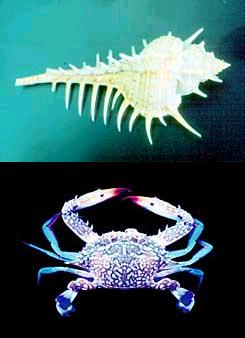The invaders will infiltrate more easily, the locals will be forced to go down to the shelters
Zafarir Rinat

An alien attack threatens the Mediterranean Sea, and it could wreak havoc on ecosystems and affect economic sectors such as fishing and tourism. These are not aliens from space, but animals from the Red Sea and the Indian Ocean, which will invade the Mediterranean through the Suez Canal. This invasion already takes place on a regular basis in the canal, but it may expand to a considerable extent following the Egyptian government's intention to expand and deepen it.
The use of the term "aliens" in this context is not an invention of the press but of scientists who chose it to illustrate the problem of the invasion of alien species. In the case of the Suez Canal, the Israeli researcher Prof. Bela Galil, from the Sea and Lakes Research Institute in Haifa, is the one who has recently been trying to warn of the imminent danger of invasion.
According to the information that reached Prof. Galil, Egypt intends to expand the Suez Canal up to 400 meters. The maximum width of the canal today is 365 meters. Also, the Egyptians intend to deepen the canal by a few more meters; These operations will allow the passage of huge oil tankers, which currently cannot cross it. The payment for the passage of the tankers will greatly increase Egypt's income.
To carry out the works, the Canal Authority, acting on behalf of the Egyptian government, ordered a special digging device from the Japanese company "Mitsubishi". According to Mitsubishi, this is the largest device of its kind ever made: its bucket is capable of loading ten thousand tons of dirt at a time.
Today, scientists know about 300 species of marine animals that passed through the Suez Canal to the Mediterranean Sea, and it is estimated that there are additional species that have not yet been discovered. Some of the invaders thrived in the Mediterranean and began to spread to large areas. Such is the case of the crab from the wandering boat species, which was first seen in the Mediterranean eighty years ago and since then has spread and become a sought-after food. Another species that spread in the eastern Mediterranean is the scarlet snail forskoli.
The result of this invasion in many cases is the destruction of the existing structure of the local animal society, which is unique to the Mediterranean. Local species of oysters, snails and other animals could not compete with the invaders and were pushed out or disappeared from many places. A striking example of this process is the takeover of the Japanese panon, a chassilon that fishermen call crystal. The halibut has become the most popular in the eastern Mediterranean, and Israeli fishing vessels specialize in catching it. Scientists estimate that he caused the disappearance from the area of a local species of Hasilon. Another example is an oyster of the species Pharaonic mud, which came through the Suez Canal and displaced the local species, a small mud. There were times when native species of animals had to move to greater depths to survive.
Some of the invaders, like the jellyfish known from the shores of Israel, have become a nuisance. These jellyfish, of the wandering filamentous species, appear in swarms that sometimes stretch for a hundred kilometers. They clog the openings of cooling channels in power plants and interfere with the distribution of fishing nets.
Prof. Galil estimates that the widening and deepening of the canal will allow many species to pass through the canal. For example, species that could not pass through the canal until now because they live at a depth several meters greater than its depth, will be able to do so after the deepening. Galil says that this way, among other things, other species of crabs and fish will reach the Mediterranean Sea.
Galil does not propose that the Egyptians cancel the expansion plans. According to her, in various canals in the world, such as the Panama Canal, there are large doors that block the canal openings and open only when a vessel approaches it. "I'm not an engineer, but I believe that it is necessary to consider erecting such doors and injecting water with a high degree of salinity between them," she said. The animals that manage to infiltrate the canal, despite the doors, will not be able to exist in the salty water. Galil raised the proposal at meetings of organizations dealing with the preservation of the Mediterranean Sea, but so far without results.
Courtesy of Walla news

One response
Aammmmmmmmmm!!!!!!! How scary is this O: